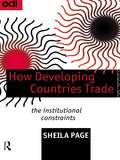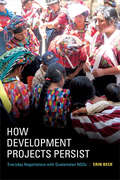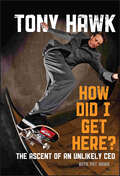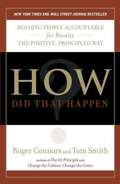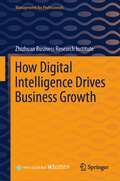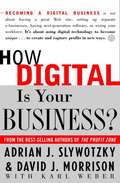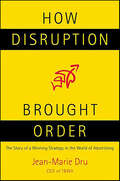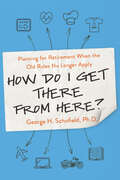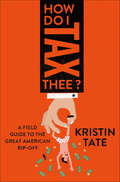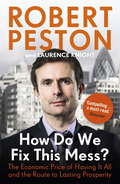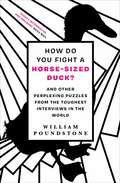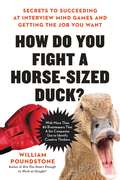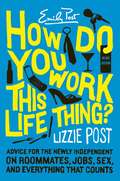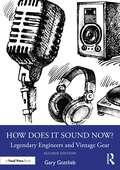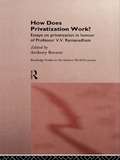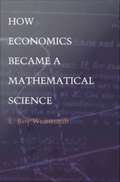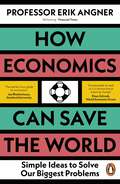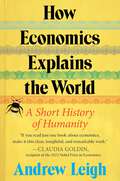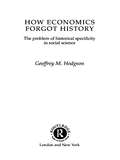- Table View
- List View
How Developing Countries Trade: The Institutional Constraints
by Sheila PageOver the last fifteen years there have been dramatic increases in both private and public intervention in international trade. Traditional barriers to market-based trade such as commodity cartels and tariffs have been augmented by new developments such as the rise of regional trade blocs and the growth of intra-firm trade. This book argues that the
How Development Projects Persist: Everyday Negotiations with Guatemalan NGOs
by Erin BeckIn How Development Projects Persist Erin Beck examines microfinance NGOs working in Guatemala and problematizes the accepted wisdom of how NGOs function. Drawing on twenty months of ethnographic fieldwork, she shows how development models and plans become entangled in the relationships among local actors in ways that alter what they are, how they are valued, and the conditions of their persistence. Beck focuses on two NGOs that use drastically different methods in working with poor rural women in Guatemala. She highlights how each program's beneficiaries—diverse groups of savvy women—exercise their agency by creatively appropriating, resisting, and reinterpreting the lessons of the NGOs to match their personal needs. Beck uses this dynamic—in which the goals of the developers and women do not often overlap—to theorize development projects as social interactions in which policymakers, workers, and beneficiaries critically shape what happens on the ground. This book displaces the notion that development projects are top-down northern interventions into a passive global south by offering a provocative account of how local conditions, ongoing interactions, and even fundamental tensions inherent in development work allow such projects to persist, but in new and unexpected ways.
How Did I Get Here
by Tony Hawk Pat HawkThe most famous skateboarder ever shares the business secrets to his success!He's the man who put skateboarding on the map. He's the first to land a 900 (two and a half full rotations). He's also among the richest pitchmen in any sport. And, in a sport that's especially youth-oriented, Tony Hawk, a 40-something father of four, still connects with his audience by staying true to who he is.Moving easily between the ramp and the boardroom, Tony currently runs one of the most acclaimed action sports companies, a clothing line, and video game series bearing his name that has sold over $1 billion worldwide, making it the biggest selling action sports game franchise in game history. He has secured endorsement deals with major brands such as McDonalds, Intel, T-Mobile and Kohl's; started the Boom Boom HuckJam action sports tour; and achieved worldwide acclaim from the ESPN X Games.Filled with Tony's typical modesty and humor, How Did I Get Here? tells the amazing story behind Tony Hawk's unprecedented success from skateboarder to CEO, and the secrets behind his lasting appeal. You'll find out how authenticity has served him well in all his achievements. You'll also understand how his story has shaped many of his fundamental values, including his huge desire to win and his strong sense of realism.Get the inside story of Tony Hawk beyond the skateboard as he answers the question: How Did I Get Here?
How Did That Happen?
by Roger Connors Tom SmithThe New York Times bestseller that provides a simple, proven approach to improve accountability and the bottom line. The economy crashes, the government misfires, businesses fail, leaders don't lead, managers don't manage, and people don't follow through, leaving us asking, "How did that happen?" Surprises caused by a lack of personal accountability plague almost every organization today, from the political arena to large and small businesses. How Did That Happen? offers a proven way to eliminate these nasty surprises, gain an unbeatable competitive edge, and enhance performance by holding others accountable the positive, principled way. As the experts on workplace accountability and the authors of The Oz Principle, Roger Connors and Tom Smith tackle the next crucial step everyone can take, whether working as a manager, supervisor, CEO, or individual performer: creating greater accountability in all the people on whom you depend.
How Digital Intelligence Drives Business Growth (Management for Professionals)
by Zhizhuan Business Research InstituteThis book aims to build a framework for understanding how to achieve new business growth through digital intelligence. It reveals the driving force and commercial logic behind the technology upgrade and transformation for enterprises, analyzes how to improve enterprises' branding, product, distribution channel, marketing, logistics, and organization under the new context, and studies the successful cases in digital intelligence of 6 Chinese enterprises. For business school students, researchers, managers, and practitioners, it is helpful to build an overview and understanding on strategy level as well as practice level.
How Digital Is Your Business?
by Adrian J. Slywotzky Karl Weber David MorrisonThe biggest, most important issue in business today--becoming digital--touches not only traditional enterprises but the most avant-garde of Internet companies as well.Old-economy companies must take steps to avoid becoming victims of capitalism's creative destruction, the unofficial system that flushes out the old to make way for the new. For dot-com companies the question is whether or not they are flash-in-the-pan businesses with no long-term prospects of profitability and customer loyalty.Most of the early efforts to answer the question "How digital is your business?" have been shrouded in techno-speak: a veritable Tower of Babel unconnected with the real needs of business. Slywotzky and Morrison show, first of all, that becoming digital is not about any of the following: having a great Web site, setting up a separate e-business, having next-generation software, or wiring your workforce.What they so creatively demonstrate is that a digital business is one whose strategic options have been transformed--and significantly broadened--by the use of digital technologies. A digital business has strategic differentiation, a business model that creates and captures profits in new ways and develops powerful new value propositions for customers and talent. Above all, a digital business is one that is unique.How Digital Is Your Business? is a groundbreaking book with universal appeal for everyone in the business world. It offers:* Profiles of the future: the in-depth story of the digital pioneers--Dell Computer, Charles Schwab, Cisco Systems, Cemex.* Insight into how to change a traditional enterprise into a digital business: the stories of GE and IBM. * An analysis of the profitable dot-coms: AOL, Yahoo!, and eBay.While How Digital Is Your Business? has great stories and case studies, its most invaluable central idea is that of digital business design and the array of powerful digital tools it offers for use in creating a digital future for your own company.
How Disruption Brought Order: The Story of a Winning Strategy in the World of Advertising
by Jean-Marie Dru“Quite simply and without a shadow of a doubt the best book about advertising ever written . . . a treasure trove of brilliant examples and anecdotes.” ―Donald Gunn, Founder, The Gunn ReportIn his previous bestselling books, global advertising icon Jean-Marie Dru explored the visionary, innovative techniques that have become a hallmark of TBWA Worldwide campaigns. Now he gives a first-hand account of how the bold methods of disruption launched TBWA to the forefront of international advertising. Here he shares personal insights and anecdotes about his life in advertising as well as lessons learned, revealing how client campaigns for Nissan, Adidas, and the Apple iPhone became such unqualified successes. Both a fascinating business memoir and a practical guide to harnessing the power of disruption, this book offers a look at the cutting edge of modern advertising.“In this honest, fast-paced, and endlessly useful book, Jean-Marie Dru, a disruptive thinker who has helped so many great companies redefine their brands and marketing messages, explains how his one-of-a-kind company works—and how his ideas can help you rethink how your company works and wins.” ―William C. Taylor, New York Times–bestselling author“All great breakthrough business ideas have involved breaking with convention, but Dru's penchant for articulating the need for creative destruction brings decisiveness and encouragement to a field that constantly searches for ways to bring renewal to the process.” ―Booklist“From the CEO down, we live at a time when every organization should be looking at their business in a creative way. If you don't know how to do it, read this book.” ―Terry Savage, Executive Chairman, Cannes Lions International Advertising Festival
How Do I Get There from Here?: Planning for Retirement When the Old Rules No Longer Apply
by George H. SchofieldNo matter how far or close you think you are to retirement, this book is your one-stop guide to help you plot your direction for the coming decades.Not long ago everyone knew what the word retirement meant--retire at age 65 after 40 years at the same job and coast through your golden years courtesy of a comfortable nest egg. But now, age expectancy is higher, savings are slimmer, and people change jobs more frequently. Clinging to this outdated concept of retirement only gets you a room in your kids&’ house. Your retirement is going to require an incremental approach to planning--and you must begin now. This requires conscious engagement, diverse interests, and the ability to adapt.In How Do I Get There from Here?, readers will first be directed how to review all their assets--both tangible and intangible--so they can get an honest assessment of where they are right now. Then a journey through self-reflective questions and exercises will:walk you through imagining your future,identifying skills you&’ll need,and learning how to prepare for inevitable twists and turns along the way.Stop clinging to an ancient and stereotypical idea of retirement. Decades of nonstop leisure is not only unreachable for most, it&’s not even truly desirable. Begin now charting the path for a unique, dynamic future you can look forward to!
How Do I Tax Thee?: A Field Guide to the Great American Rip-Off
by Kristin TateLibertarian journalist Kristin Tate provides a look into the wild world of frivolous taxation, aimed at educating members of her own generation in the evils of big government.In How Do I Tax Thee?, libertarian commentator and rising media star Kristin Tate takes us on a tour of the ways the government bleeds us dry in innumerable daily transactions and at various stages of life. We all know the government taxes our pay: federal, state, and local taxes are withheld by employers, as are social security payments. But what about the many other ways the government drains money from our wallets? Have you studied your cell phone bill? Customers in New York State pay an average of 24.36% in federal, state and local taxes on their wireless bills. They’re also charged for obscure services they didn’t ask for and don’t understand like a universal service fund fee, an FCC compliance fee, a line service fee, and an emergency services fee. These aren’t taxes, strictly speaking. The government imposes these administrative and regulatory costs, and your wireless provider passes them along to you. But the effect is exactly the same. What about your cable bill? Your power bill? Your water bill? The cost of a gallon of gas, a cab ride, a hotel stay and a movie ticket are all inflated by hidden fees. How much of what you pay at the pump, the box office, or the airport is really an indirect tax? In a series of short, pointed, fact-laden, humorous chapters, Tate exposes the vast government shakedown that consumes up to half of your income—and also explains where these hidden fees and taxes come from.
How Do We Begin?: Teaching Adaptive Leadership
by Sharon D. ParksThis chapter steps directly into a classroom in which the case-in-point teaching method is used, immersing the reader in the actual dynamics of the opening session of a course on Exercising Leadership at Harvard.
How Do We Fix This Mess?
by Robert PestonIn Robert Peston's new book he explains in his characteristically straightforward way how the world got itself into the current economic mess - and how we might get out of it. 'How do we fix this mess? I don't know. But don't stop reading now. Perhaps if we have a clearer understanding of what went wrong, we'll have a better idea of what needs to be done. This book is a map of what needs to be fixed.' The record-breaking unbroken growth between 1992 and 2008 wasn't the economic miracle that it seemed. It was based on a number of dangerous illusions - most notably that it didn't matter that the UK and US year after year consumed more than they earned. But we couldn't go on increasing our indebtedness forever. The financial crash of 2007/8 and the subsequent economic slump in much of the west was the moment when we realised we had borrowed more than we could afford to repay. So who got it wrong? Bankers, investors and regulators? And were they greedy, stupid or asleep? What was the role of government? And what part did we, as consumers, play in all this? How do we get through this difficult period of transition to a more sustainable economy, one based on investment and exports, rather than on borrowing and consumption? With the same probing lucidity he brought to WHO RUNS BRITAIN?, Robert Peston takes us step-by-step towards a common sense way to fix this mess.
How Do We Fix This Mess? The Economic Price of Having it all, and the Route to Lasting Prosperity
by Robert Peston'Robert Peston's compelling account of global financial meltdown is a must-read.' ObserverWhat can we learn from the 2008 recession? ITV's political editor explains the global economic mess and how to escape it - in his characteristically straightforward way. 'How do we fix this mess? I don't know. But don't stop reading now. Perhaps if we have a clearer understanding of what went wrong, we'll have a better idea of what needs to be done. This book is a map of what needs to be fixed.'The record-breaking unbroken growth between 1992 and 2008 wasn't the economic miracle that it seemed. It was based on a number of dangerous illusions - most notably that it didn't matter that the UK and US year after year consumed more than they earned.But we couldn't go on increasing our indebtedness forever. The financial crash of 2007/8 and the subsequent economic slump in much of the west was the moment when we realised we had borrowed more than we could afford to repay.So who got it wrong? Bankers, investors and regulators? And were they greedy, stupid or asleep? What was the role of government? And what part did we, as consumers, play in all this? How do we get through this difficult period of transition to a more sustainable economy, one based on investment and exports, rather than on borrowing and consumption? With the same probing lucidity he brought to Who Runs Britain? and WTF?, Robert Peston takes us step-by-step towards a common sense way to fix this mess.
How Do You Fight a Horse-Sized Duck?: And Other Perplexing Puzzles from the Toughest Interviews in the World
by William PoundstoneEvery year, millions of applications stream to a handful of companies that regularly top the listings of best employers: Apple, Netflix, Amazon, Alphabet, Disney, SpaceX, Oracle, PricewaterhouseCoopers and others. In 2017, Tesla received as many as 200 applications for each vacancy, making it ten times more selective than Harvard. The only way to choose who to hire is with uniquely demanding questions that test imagination, persistence and creativity. Questions like: How is a milk carton like a plane seat? Why don&’t animals have wheels? What would happen if you drilled a hole all the way through the Earth and jumped in it? How Do You Fight a Horse-Sized Duck? explores the new world of interviewing at A-list employers. It reveals more than 70 outrageously perplexing riddles and puzzles and supplies both answers and general strategy for creative problem-solving.
How Do You Fight a Horse-Sized Duck?: Secrets to Succeeding at Interview Mind Games and Getting the Job You Want
by William PoundstoneLearn how to succeed at interview mind games and win job offers at A‑list companies, with more than eighty difficult and devious questions, puzzles, and brain teasersEach year about 28 million Americans begin a search for a new job. Many more live in the age of the permanent job search, their online profiles eternally awaiting a better offer. Job seekers are more mobile and better informed than ever, aspiring to work for employers offering an appealing culture, a robust menu of perks, and opportunities for personal fulfillment and advancement. The result is that millions of applications stream to the handful of companies that regularly top listings of the best companies to work for: Apple, Netflix, Amazon, Alphabet, Disney, SpaceX, Oracle, Pricewaterhouse-Coopers, and others. Tesla has received as many as 200 applications for each open position. How do selective employers choose which people to hire? It&’s through interviews asking uniquely demanding questions testing imagination, persistence, and creativity, like: Can an astronaut throw a baseball so it hits Earth? If you had $2,000, how would you double it in 24 hours? How is a milk carton like a plane seat? Chicken McNuggets come in boxes of 6, 9, and 20. What&’s the largest number of McNuggets that McDonald&’s can&’t sell you? How many dogs in the world have the exact same number of hairs?How Do You Fight a Horse-Sized Duck? explores the new world of interviewing at A-list employers. It reveals more than eighty notoriously challenging interview questions and supplies both answers and a general strategy for creative problem-solving.
How Do You Find What Matters in Experience?: Becoming a More Effective Leader
by Robert J. ThomasHow do leaders grow and improve? This chapter describes crucible experiences-experiences that lead to a new or altered sense of identity-and more importantly, leaders' reactions to crucible experiences, as central to enhancing leadership performance.
How Do You Grow a Premium Brand? (HBR Case Study and Commentary)
by David A. Aaker Regina Fazio Maruca Robert J. Dolan Mary Shelman Anita K. Hersh Peter H. Farquhar William CampbellGordon Johnston has taken his elite health-club concept from the germ of an idea to the pinnacle of success. But the most difficult decision in managing his company lies ahead. Gordon must figure out how to lead Transition fitness clubs into the next phase. In each of the 15 years since Transition's flagship club opened in New York City, its sales have doubled. The company boasts fitness trainers handpicked by Olympic medalists, health-conscious cuisine by in-house chefs, huge facilities in prime locations, and reciprocal memberships at other Transition clubs worldwide. But recently, the company's margins have been shrinking. An aging membership could mean problems for future expansion. And new, upscale competitors are challenging Transition's flat-rate pricing policy. Will Gordon have to run fast to stay in one place? Should he change Transition's pricing policy? In 95205 and 95205Z, William Campbell, Robert J. Dolan, Anita K. Hersh, Peter H. Farquhar, David Aaker, and Mary Shelman offer advice on this fictional case study.
How Do You Know When the Price Is Right?
by Robert J. DolanToo often when managers think about pricing, the first question they ask is, What should the price be? In fact, what they should be asking is, Have we addressed all the considerations that will determine the correct price? Robert J. Dolan describes two broad qualities of an effective pricing process and provides eight steps to enable managers to develop and use such a process. The pricing scorecard included at the end of the article will allow managers to evaluate how well their pricing practices meet these guidelines.
How Do You Manage an Off-Site Team? (HBR Case Study and Commentary)
by Regina Fazio Maruca John R. Birstler Robert M. Egan Margaret Klayton-Mi Wendy MilesIn this fictitious case study, HBR editor Regina F. Maruca explores the challenges of managing employees in the alternative workplace. Allison Scher is threatening to quit. Penny Ryan wants to run the team. The manager of these off-site workers, Craig Bedell, feels blindsided by their conflict. And the whole mess has Maggie Pinto, the head of HR, wondering if she should cancel the companywide rollout of the telecommuting program. How did this situation get to the boiling point so quickly? Craig doesn't really know. From his vantage point--inside the office--his department is doing the best work it has ever done before. And the flexible work arrangements, designed on a case-by-case basis, have increased productivity and boosted morale at the same time. Or so Craig believed--until a few days ago, when the E-mail messages started to come. There was trouble between Penny and Allison. How serious was the situation? It was hard to tell. Craig responded with E-mail and voice-mail messages of his own. Couldn't it all be put on hold until Monday, when the team would come together for its biweekly meeting? Then he got the final E-mail from Allison--the one in which she threatened "to seek alternative employment." Is the breakdown in communication irrevocable? Can Craig, who learned how to manage during a time when people showed up at the office every day, adjust to the conditions of telecommuting? Four commentators offer their advice on how the company can patch up the short-term problem and lay the foundation for a successful future. In 98405 and 98405Z, Robert M. Egan, Wendy Miles, John R. Birstler, and Margaret Klayton-Mi offer their advice on how the company can patch up the short-term problem and lay the foundation for a successful future.
How Do You Work This Life Thing?: Advice for the Newly Independent on Roommates, Jobs, Sex, and Everything That Counts
by Lizzie PostYou're on your own—and it's great! Except when problems crop up: roommate hassles, dating dilemmas, work stuff, social stuff, and just stuff. Finally, expert help is here. In How Do You Work This Life Thing? Lizzie Post, great-great-granddaughter of Emily Post, shows how to navigate the pleasures and perils of independent life, offering advice on everything from getting along with roommate(s) and dating to getting the job you want. Highlights include Prospective Roommate Checklist . . . Romance, Dating, and Sex at Your Place . . . The Get-It-Together Party Prep List . . . What to Wear When . . . Cell Tips: What to Do Where . . . Top Ten Table Manners . . . Dating 101 . . . Tipping 101 . . . Landing the Perfect Job Lizzie's down-to-earth style and tales from personal experience, coupled with sound advice in the Emily Post tradition, makes this a real-life guide you can trust.
How Does It Sound Now?: Legendary Engineers and Vintage Gear
by Gary GottliebHow Does It Sound Now? features 32 interviews with top engineers and producers who have contributed to hundreds of millions of albums and CDs throughout their combined careers, including a new interview with Leslie Gaston-Bird for this second edition.Winner of the 2010 Association for Recorded Sound Collections' Award for Excellence in Historical Recorded Sound Research, the second edition of How Does It Sound Now? allows readers to benefit from the collective experience of 32 industry heavyweights, whose interviews provide a comprehensive overview of the changes in methodology and equipment over the last 60 years. The collection focuses on engineers who made the transition through different technologies—analog to digital, wire to tape, and CD to mp3—and explores the methodology they employed when confronted with new and evolving technology. With a wide range of interviewees, from Phil Ramone to Geoff Emerick, discussions are centered around how producers and engineers retain quality and continue to create a product that conforms to their own high standards in the face of changing technologies.The techniques described will be valuable to students of audio history or theory and recording courses, and will also be of interest to audio professionals, including home recordists and studio owners, who can use this book to educate their staff and offer to clients.
How Does Privatization Work? (Routledge Studies in the Modern World Economy #No.9)
by Anthony BennettPrivatization has been one of the most important elements of public policy in the last decade and there have been massive transfers of ownership from the public to the private sector on a national and international level. This book combines thematic papers with country case studies to discuss the mechanisms which have enabled this to occur, and to assess privatization's mixed achievements. The authors, international academics, practitioners and consultants and the process of privatization is discussed in East Germany, Nigeria, Pakistan, Guyana, Sri Lanka, Trinidad and Tobago, and Great Britain.
How Economics Became a Mathematical Science
by E. Roy WeintraubIn How Economics Became a Mathematical Science E. Roy Weintraub traces the history of economics through the prism of the history of mathematics in the twentieth century. As mathematics has evolved, so has the image of mathematics, explains Weintraub, such as ideas about the standards for accepting proof, the meaning of rigor, and the nature of the mathematical enterprise itself. He also shows how economics itself has been shaped by economists' changing images of mathematics. Whereas others have viewed economics as autonomous, Weintraub presents a different picture, one in which changes in mathematics--both within the body of knowledge that constitutes mathematics and in how it is thought of as a discipline and as a type of knowledge--have been intertwined with the evolution of economic thought. Weintraub begins his account with Cambridge University, the intellectual birthplace of modern economics, and examines specifically Alfred Marshall and the Mathematical Tripos examinations--tests in mathematics that were required of all who wished to study economics at Cambridge. He proceeds to interrogate the idea of a rigorous mathematical economics through the connections between particular mathematical economists and mathematicians in each of the decades of the first half of the twentieth century, and thus describes how the mathematical issues of formalism and axiomatization have shaped economics. Finally, How Economics Became a Mathematical Science reconstructs the career of the economist Sidney Weintraub, whose relationship to mathematics is viewed through his relationships with his mathematician brother, Hal, and his mathematician-economist son, the book's author.
How Economics Can Save the World: Simple Ideas to Solve Our Biggest Problems
by Erik AngnerEconomics has the power to make the world a better, happier and safer place: this book shows you howOur world is in a mess. The challenges of climate change, inequality, hunger and a global pandemic mean our way of life seems more imperilled and society more divided than ever; but economics can help!From parenting to organ donation, housing to anti-social behaviour, economics provides the tools we need to fix the biggest issues of today. Far from being a means to predict the stock market or enrich the elite, economics provides a lens through which we can better understand how things work, design clever solutions and create the conditions in which we can all flourish.With a healthy dose of optimism, and packed with stories of economics in everyday situations, Erik Angner demonstrates the methods he and his fellow economists use to help improve our lives and the society in which we live. He shows us that economics can be a powerful force for good, awakening the possibility of a happier, more just and more sustainable world.
How Economics Explains the World: A Short History of Humanity
by Andrew Leigh“If you read just one book about economics, make it Andrew Leigh's clear, insightful, and remarkable (and short) work.” —Claudia Goldin, recipient of the 2023 Nobel Prize in Economics and Henry Lee Professor of Economics at Harvard UniversityA sweeping, engrossing history of how economic forces have shaped the world—all in under 200 pagesIn How Economics Explains the World, Harvard-trained economist Andrew Leigh presents a new way to understand the human story. From the dawn of agriculture to AI, here is story of how ingenuity, greed, and desire for betterment have, to an astonishing degree, determined our past, present, and future. This small book indeed tells a big story. It is the story of capitalism – of how our market system developed. It is the story of the discipline of economics, and some of the key figures who formed it. And it is the story of how economic forces have shaped world history. Why didn’t Africa colonize Europe instead of the other way around? What happened when countries erected trade and immigration barriers in the 1930s? Why did the Allies win World War II? Why did inequality in many advanced countries fall during the 1950s and 1960s? How did property rights drive China’s growth surge in the 1980s? How does climate change threaten our future prosperity? You’ll find answers to these questions and more in How Economics Explains the World.
How Economics Forgot History: The Problem of Historical Specificity in Social Science (Economics As Social Theory Ser.)
by Geoffrey M HodgsonIn arguably his most important book to date, Hodgson calls into question the tendency of economic method to try and explain all economic phenomena by using the same catch-all theories and dealing in universal truths. He argues that you need different theories to analyze different economic phenomena and systems and that historical context must be ta
